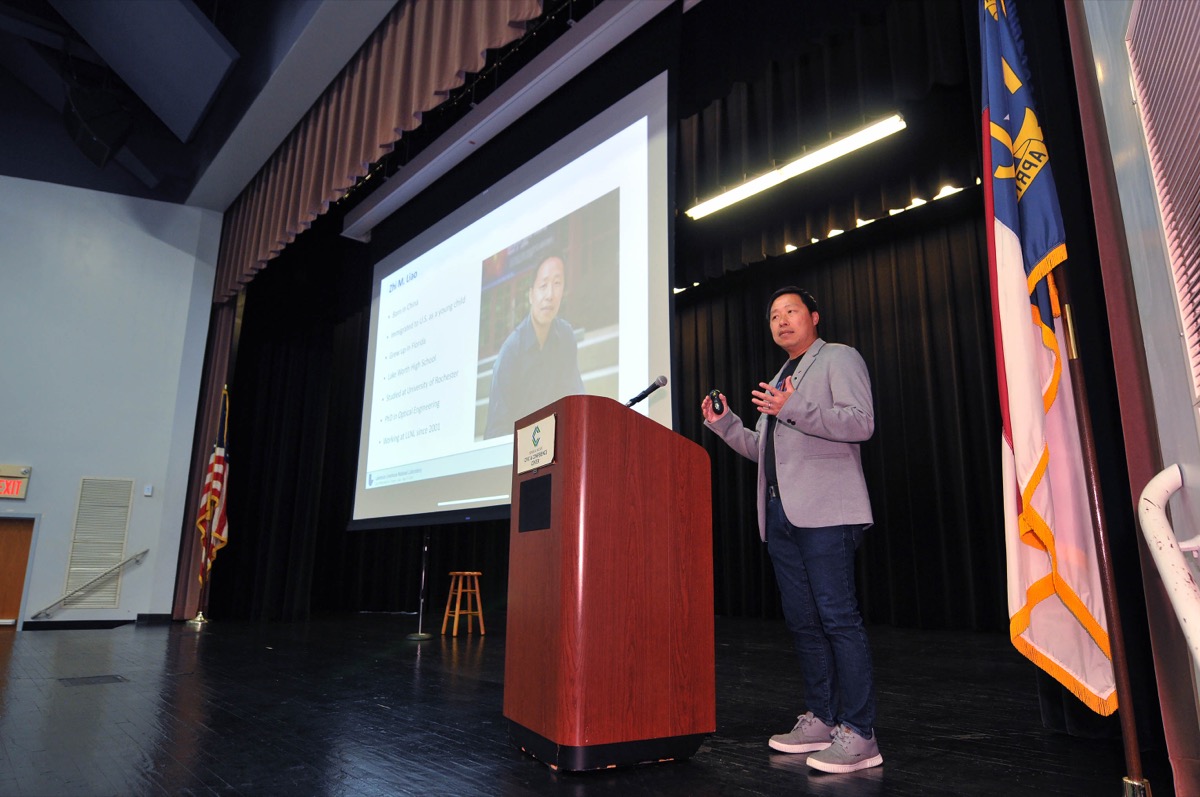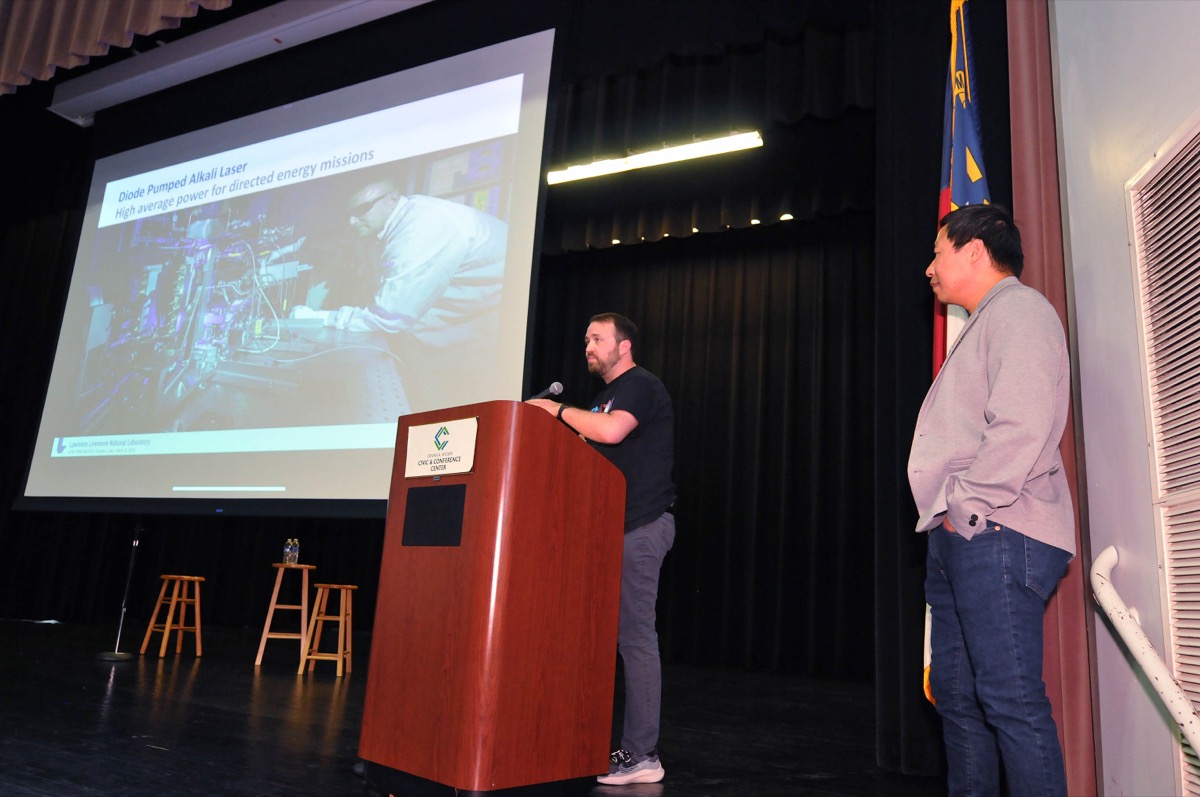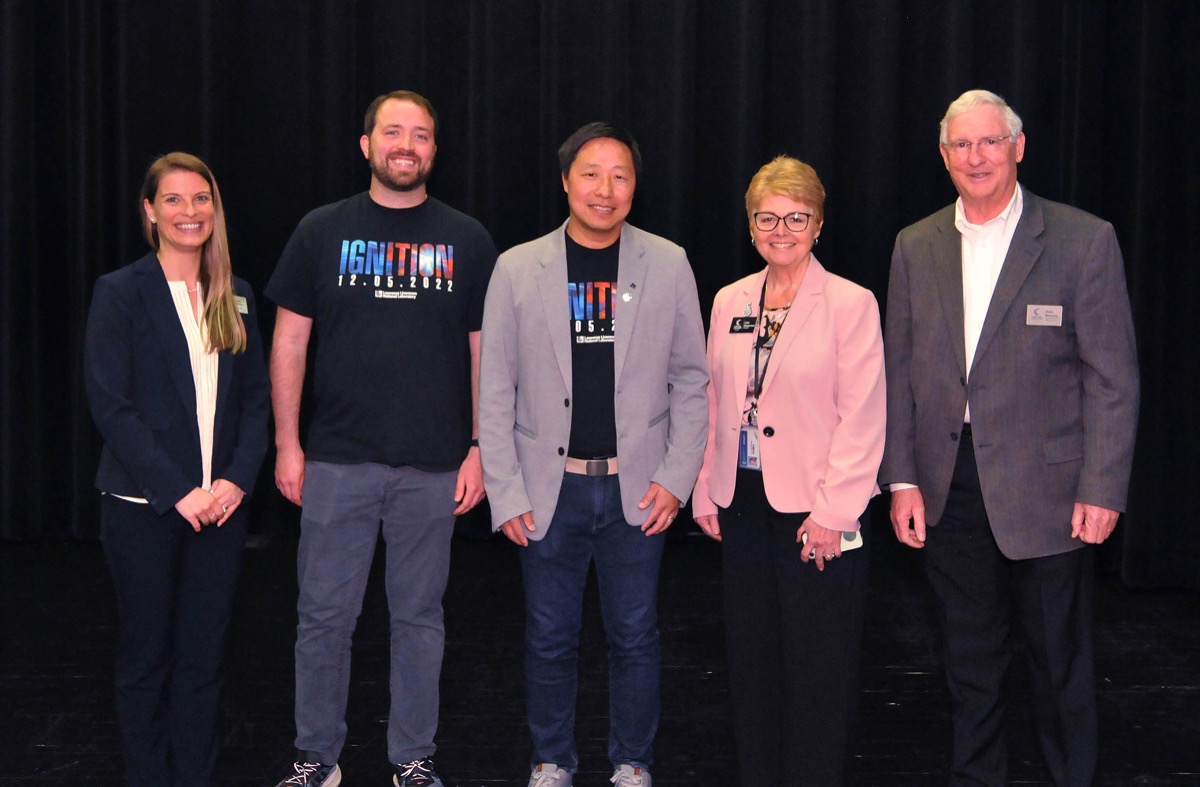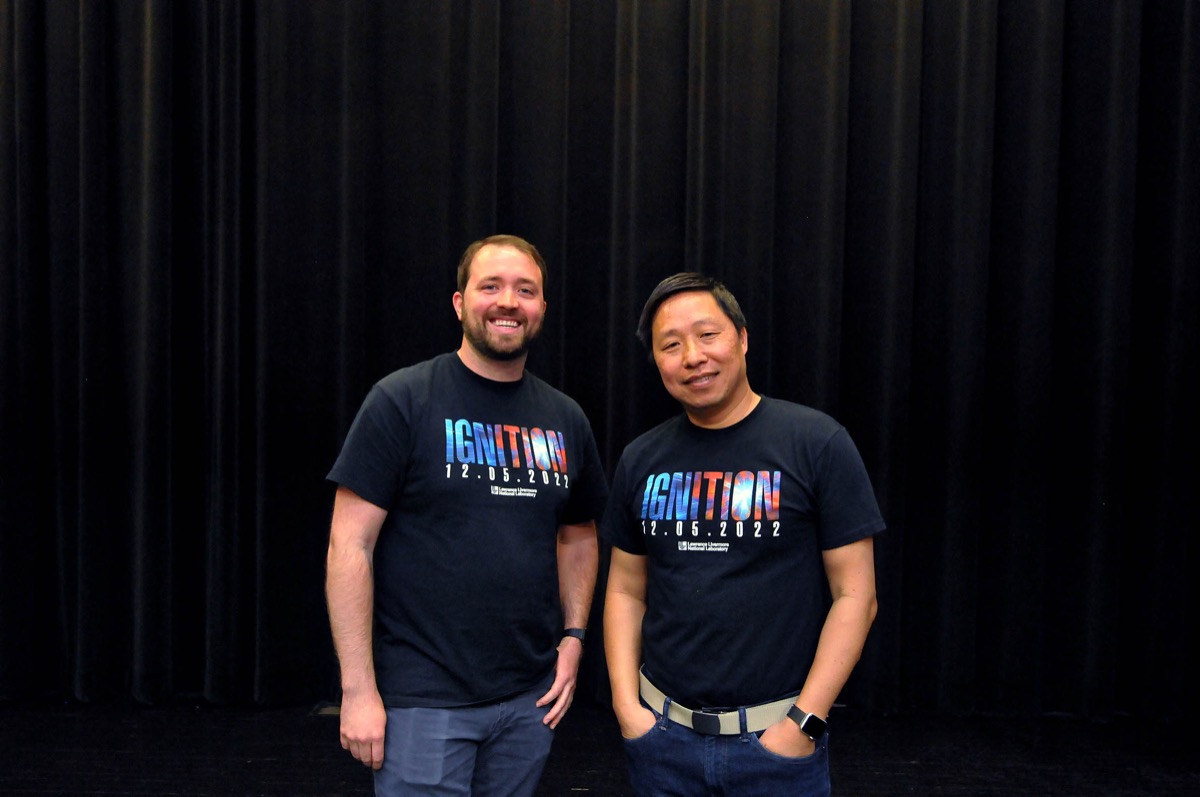College News
Fusion ignition is subject of presentation at CCCC
Notice: This article is older than 12 months. Names, contact information, programs, titles, etc. might have changed. If you have any problems please call the main college number, 1-800-682-8353, and we will be happy to direct you accordingly.

click image to enlarge ⊗
Dr. Zhi M. Liao, of Lawrence Livermore National Laboratory, spoke about the nuclear fusion breakthrough ... (more)

click image to enlarge ⊗
David Pope (left) and Dr. Zhi M. Liao, both of Lawrence Livermore National Laboratory, visited Central ... (more)

click image to enlarge ⊗
David Pope (second from left) and Dr. Zhi M. Liao (center), both of Lawrence Livermore National Laboratory, ... (more)

click image to enlarge ⊗
Central Carolina Community College graduate David Pope (left) and Dr. Zhi M. Liao, both of Lawrence ... (more)
05.01.2023 • College & Community • College General • Special Events
SANFORD - When successful fusion ignition was announced late last year, the news rocked an entire world. Headlines screamed on the front page of the New York Times: "A Blast of 192 Lasers Achieves a Breakthrough in Nuclear Fusion."
Barely one month later, 60 Minutes had already toured the lab, conducted interviews and produced a television documentary segment for the long-running news show. "If fusion becomes commercial power one day, it would be endless and carbon-free," it began. "In other words, it would change human destiny."
One of the scientists responsible for one of the world's great discoveries traveled to Sanford to discuss the breakthrough on April 25 at Central Carolina Community College. The 70-minute, standing-room-only presentation was hosted by the CCCC STEM Career Community, one of seven areas of study created to bring together students with shared interests.
The Path to Discovery
Fusion reactions in nature provide the energy that powers our sun and the stars. And fusion ignition, what was demonstrated in a laboratory for the first time, is the point when the reaction generates more energy than was required to create it.
Scientists have been researching fusion ignition for more than a century and working to achieve it for more than 60 years. That path has been filled with obstacles and disappointment, but the breakthrough moment finally arrived on December 5 in California at the Lawrence Livermore National Laboratory.
Dr. Zhi M. Liao was part of it all. Born in China before immigrating to the United States during his childhood, Liao didn't know what he wanted to do with his life; in fact, while in high school, he took a career-guidance assessment that suggested becoming an air traffic controller. But after enrolling in the University of Rochester and completing a junior-year summer internship at the Lawrence Livermore National Laboratory, his future became clear: laser optics.
Eventually, he earned the Ph.D. in Optical Engineering and returned to the Lawrence Livermore National Laboratory, working 25 years as a laser physicist before shifting into his current role as workforce manager for the organization's National Ignition Facility and Photon Sciences Directorate.
Liao began his presentation at the Dennis A. Wicker Civic & Conference Center with a short video summarizing the discovery before describing the chemical interaction. Working in a research facility the size of three football fields, scientists focused 192 laser beams on a tiny target, sending the laser beams through a complex system that amplified their strength and even changed their geometry before finally striking a centimeter-sized, hollow cylinder where the chemical reaction occurred.
Inside the cylinder, two different forms of hydrogen were forced together by extreme temperature and pressure, fusing their nucleuses together to form another chemical element and, in the process, releasing energy. How extreme? "It produced an environment that was 100 million degrees temperature, 10 million degrees pressure," Liao said about the microscopic, momentary reaction. "That's hotter than the center of the sun. Think about that for a moment there: When our laser is fired, we're the hottest spot in the solar system. That includes the sun."
Man-made fusion has been around since the 1950s, but what makes this discovery such an important breakthrough, Liao said, is that it took only 2.05 megajoules of energy to produce 3.15 megajoules of energy. In other words, for the first time ever, scientists showed how nuclear fusion could be used to generate energy in a process that could eventually be used to provide the world with unlimited amounts of clean power. (Not to mention all kinds of other possibilities, like opening space travel over distances currently limited by how much fuel can be carried on board the spacecraft.)
Success was achieved after a long and often-frustrating process. As scientists made progress toward their ultimate goal, new obstacles emerged that had to be overcome. More than 800 experiments were conducted over a decade to make it happen and, even before that, lasers had to improve over many decades to produce the kind of energy required. "A lot of history, a lot of failures," Liao said. "But with every failure, you learn, you overcome and then you proceed."
The Local Connection
Liao came to Central Carolina Community College because of its Laser and Photonics Technology program, the only one of its kind on the East Coast. According to the college website, the program "teaches students how to control light and electrical energy to prepare them for careers in photonics and electronics engineering technology."
Like all community college programs, the laser program has a local focus. While most of its graduates end up working for local companies -- maybe as technicians or field service engineers in companies like Cree LED, Apex Semiconductors or Wolfspeed -- some talented graduates have migrated to the Lawrence Livermore National Laboratory, the federally-funded research and development center considered by many to be the world's best.
One is Brandon Pasley, a CCCC graduate who worked in the control room as a member of the team directing those 192 laser beams in the historic fusion ignition experiment.
Another is David Pope, who was working on a different "game-changing" laser project at Lawrence Livermore National Laboratory, but came back to Sanford with Liao to participate in the presentation and handle some of the audience questions. Pope graduated from CCCC in 2016 with his Associate in Applied of Science degree in Laser and Photonics Technology. Almost immediately after graduation, Pope says, he packed up his Toyota Camry and headed west, where he now works as a Senior Laser Electro-Optics Technician.
CCCC's lead laser instructor Gary Beasley recalls Pope as an intensely dedicated student who already had a four-year degree before making a career change. "I knew his grandfather, who said he had a grandson who wanted to work in something hands-on and was interested in lasers," Beasley said in a conversation before the presentation. "He came into our laser laboratory one Saturday for a quick tour and immediately jumped all over it. From the beginning, he just excelled."
With so many students packed into the civic center auditorium, one of the audience questions focused on how to become successful in the field. Liao and Pope took turns responding, agreeing that students need to be willing to learn -- especially from inevitable failures along the way -- and bring a strong foundational knowledge they can apply to problems they've never seen before. Because, as Liao pointed out, "What I tell people is that what you learn in the classroom, when you come to the lab, that's not what we do. We don't do exactly that, because what we do is not in the textbooks a lot of times .... We do things nobody else does."
Pope said the path he began at CCCC was something he didn't know was possible or even existed near his North Carolina home. But that Saturday tour and eventual career change has made all the difference. "For me," he said, "it completely changed my life."
Learn more about the CCCC Laser & Photonics Technology program by visiting www.cccc.edu/lasers.
Learn more about all of CCCC's STEM Career Community offerings by visiting www.cccc.edu/curriculum.
Categories
- Admin, Faculty & Staff Category
- Arts & Entertainment Category
- Clubs Category
- College & Community Category
- College General Category
- Continuing Education Category
- Curriculum Programs Category
- Distance Education Programs Category
- Facilities/Buildings Category
- Finances Category
- Foundation Category
- Graduations Category
- Lee Early College Category
- NCCCS Category
- SGA Category
- Special Events Category
- Sports Category
- Students/Graduates Category
- Uncategorized Category
Archives

